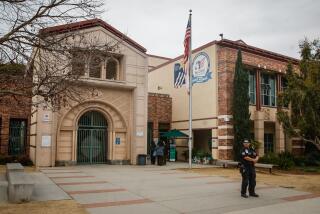L.A. Firm’s System Spots Fake Securities
- Share via
Responding to concerns about the apparently growing problem of securities counterfeiting, a Los Angeles-based firm has developed what is believed to be the first automated system to detect fake stock certificates and other bogus securities.
Light Signatures Inc. said Thursday that it is negotiating with stock-transfer agents, brokerage houses and banks for introduction of a high-speed system that “reads” certificates to verify their authenticity and to process data about transactions.
The system, to be fully operational in the first quarter of 1986, will first be used for stock certificates but is also expected to be used to verify bonds, commercial paper and other securities.
Until now, “all checking of stock certificates has been based on manual inspection,” Light Signatures Chairman Ronald A. Katz said. The technology used by Light Signatures has been endorsed by the Financial Industry Security Council, an industry group. The council recently recommended that the New York Stock Exchange require listed companies to use the technology.
“Once introduced, the technology will be widely accepted and, over a period of years, it is inevitable that every new certificate will be issued under this technology,” said Ronald W. Readmond, FISC co-chairman and operations principal at the Baltimore-based securities firm of Alex. Brown & Sons.
No one knows for sure the full extent of the fake-securities problem, Readmond said, partly because many victims are too embarrassed to report incidents. But the advent of highly advanced color photocopiers--which reproduce documents so well that it is difficult to tell them apart from originals--means that the counterfeiting problem “will be worse in the next five years than it’s ever been,” he said.
Light Signatures’ system is adapted from technology that it developed to detect counterfeit record albums and clothing. It has two components: a special printer that encodes a line of data on newly issued certificates to indicate number of shares and other information, and a high-speed terminal that can process the data and verify the certificate’s authenticity by reading the patterns created by its fiber content.
More to Read
Inside the business of entertainment
The Wide Shot brings you news, analysis and insights on everything from streaming wars to production — and what it all means for the future.
You may occasionally receive promotional content from the Los Angeles Times.
![Guitar heatmap AI image. I, _Sandra Glading_, am the copyright owner of the images/video/content that I am providing to you, Los Angeles Times Communications LLC, or I have permission from the copyright owner, _[not copyrighted - it's an AI-generated image]_, of the images/video/content to provide them to you, for publication in distribution platforms and channels affiliated with you. I grant you permission to use any and all images/video/content of __the musician heatmap___ for _Jon Healey_'s article/video/content on __the Yahoo News / McAfee partnership_. Please provide photo credit to __"courtesy of McAfee"___.](https://ca-times.brightspotcdn.com/dims4/default/f4350ab/2147483647/strip/true/crop/1600x1070+0+65/resize/320x214!/quality/75/?url=https%3A%2F%2Fcalifornia-times-brightspot.s3.amazonaws.com%2F60%2Fef%2F08cda72f447d9f64b22a287fa49c%2Fla-me-guitar-heatmap-ai-image.jpg)








